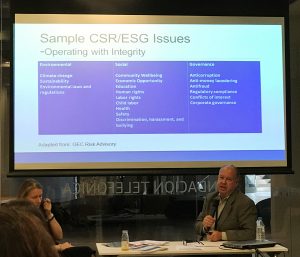 It is interesting to note that as companies move to more closely align their employee volunteer programs with their corporate social responsibility (CSR) strategy, employees are seeking more fulfillment and purpose in their lives, which sometimes take them in a different direction from their employer. CSR and employee volunteering are not mutually exclusive and both are gaining traction for different reasons.
It is interesting to note that as companies move to more closely align their employee volunteer programs with their corporate social responsibility (CSR) strategy, employees are seeking more fulfillment and purpose in their lives, which sometimes take them in a different direction from their employer. CSR and employee volunteering are not mutually exclusive and both are gaining traction for different reasons.
In an effort to recruit and retain the best and the brightest, companies are paying more attention to the needs and interests of their current and prospective employees. We hear much about purpose, purpose in life and purpose in work. Companies and society gain benefit when they engage their employees strategically. And in some cases, strategically is letting them follow their own path.
Environment, social and governance (ESG) issues, or as I like to say, how a company cooperates with integrity, is becoming more integrated into business strategy. Human capital is key to this and employee volunteering can be a bridge: a bridge between company interests and employee interests; a bridge between the company and the community; and often a bridge between different functional areas within a company. Employee volunteering creates deeper engagement for all involved.
Issues that matter can take different forms. The United Nations Sustainable Development Goals (SDGs) have provided a framework for many companies to view their social strategy. Seventeen goals covering, among others, education, gender equality, poverty alleviation, and water can help companies, and their employees, apply core competencies towards the goals’ achievement by the year 2030. We are already seeing results of volunteerism through organizations such as Points of Light, IAVE, Impact 2030 and Pyxera Global, which work closely with employers.
Much attention has been focused on skills-based and pro bono volunteering over the last ten years. I am a big proponent of skills-based volunteering and its ability to help a nonprofit better meet its mission. But I don’t think this means that helping hands volunteer projects don’t have value.
Of late, we hear a lot about transactional volunteering versus transformational volunteering. I have been thinking about how both work together with skills based and helping hands volunteering. Some examples include:
- Developing a strategy for an NGO is both skills based and transformational
- Regular bookkeeping for an organization is skills based and transactional
- Building a house for a poor family is helping hands and transformational
- Picking up trash on a beach is helping hands and transactional
All four combinations play an important role. In a company with a large and diverse workforce, providing opportunities in all four categories will meet the needs of employees and the right projects and programs can ensure the programs align solidly within the CSR strategy.
Measurement – What really counts?
This is the big question. When I first developed Disney’s global volunteer program, Disney VoluntEARS, hours were what mattered and it is a metric that many continue to use, but it is only one way of gauging participation.
Beyond hours, I now ask “so what?” What did the volunteers do? Did those hours make an actual impact? Hours are what we call inputs, what has been given, but the impacts and outcomes, as a result of the inputs, are what matter. These can be difficult to measure and it seems that those who are trying to measure impacts and outcomes have different metrics they are seeking. This makes it challenging for the collective results to be measured. Organizations such as True Impact and Mission Measurement have worked hard to better help companies and nonprofits measure what counts.
Corporate philanthropy, community investment and employee volunteering continue to become more strategic within companies’ CSR work and are more aligned with overall company mission and strategy. For now, much of the value is anecdotal, but collectively as a profession and working together, we can do a better job of demonstrating material value. Employees are companies’ most important assets, and employee volunteering is an important part of the employee experience.
This blog is based on a presentation that Jeff Hoffman gave at the IAVE European Corporate Volunteer Conference in Madrid, Spain in May, 2017.
